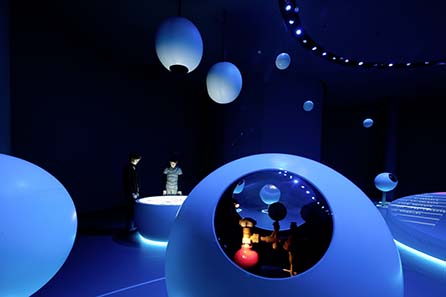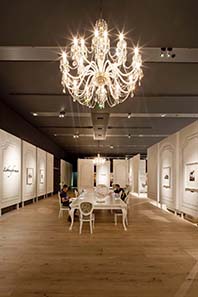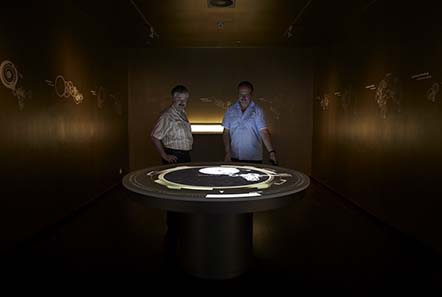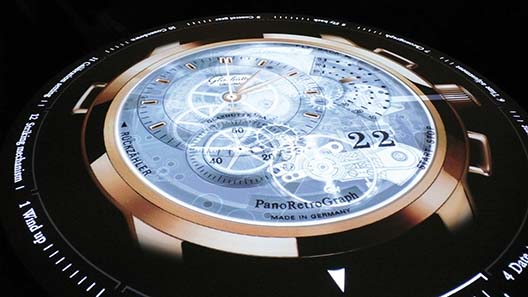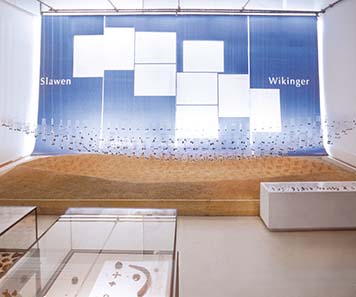September 8, 2011 – The Stuttgart ATELIER BRÜCKNER has acquired an outstanding reputation in regard to putting objects in the proper light. We talked with Prof Eberhard Schlag, management partner, how scenography can be put to use in numismatics.
A view inside the exhibition “Universe of Particles“ in CERN, Geneva. Photograph: Michael Jungblut.
CoinsWeekly: Would you please explain the difference of an exhibition planned by an academic curator alone and an exhibition designed by a scenographer.
Prof Eberhard Schlag: Like the academic curator, the scenographer takes as a starting point the content to be translated. The approach of the scenographer, however, is a holistic one. He has one eye on all means possible to clarify the message of the objects. These means are deliberately applied to the effect that, by putting the things in context, it becomes easier for the visitor to grasp the content. Hence, it is about designing a relationship between content and visitor and vice versa scenography takes care of.
CoinsWeekly: What means do you work with?
Rautenstrauch-Joest-Museum in Cologne: Rice Barn. Photograph: Michael Jungblut.
Prof Eberhard Schlag: We use means of the theater, the movie and the fine arts to create unique spatial images and spatial dramaturgy. Basis and center of consideration is always the space as means in its own right. It ‘conveys’ the messages itself. The spatial images, in turn, arise by a deliberate application of the means light, sound, graphics and digital media in conjunction with space creating design.
CoinsWeekly: How to become a scenographer? Is a special education required?
Prof Eberhard Schlag: By now, scenography actually is taught at a number of universities in Germany and the whole of Europe. My partner and founder of ATELIER BRÜCKNER, Uwe R. Brückner, for example, teaches exhibition design and scenography at the HGK in Basel. I, for my part, teach spatial communication at the HTWG in Konstanz.
Scenography is always a subject that concerns several disciplines. The multidisciplinary, cross-disciplinary working is immanent in scenography. Many scenographers have studied architecture or interior design. In addition, in ATELIER BRÜCKNER communication designer, culture historians and stage director, product designer and media designer are cooperating.
CoinsWeekly: Your motto is “form follows content“. In what form do you need the content? In other words, how am I to visualize the division of tasks between the curator and the scenographer?
Prof Eberhard Schlag: The content is our starting point that ought to express itself and become alive in the space. In close cooperation with the curator the content is specified, argued, narrowed down. The content to be translated has to be reasoned out; what objects are at disposal and what they can tell. Based on the exhibits or on an abstract content we work out suggestions as to how these contents may be expressed in space.
A view inside the exhibition “Universe of Particles” in CERN, Geneva. Photograph: Michael Jungblut.
The exhibition “Universe of Particles” in Geneva, for example, has a catchy, content-generated spatial image. All exhibits and media stations are integrated in spherical forms: the dimension and the fascination of the research work on the micro- and the macro cosmos CERN does concerning the particle accelerator.
CoinsWeekly: “As the initiator of such a three-dimensional experience, the scenographer is primarily an interpreter of what the things contain or what tasks are involved. The act of research as an experience of acquiring knowledge gives the scenographer an insight into the narrative potential of an object as well as its historical and cultural relevance, its function, its symbolism. Things are witnesses that are able to provide information about the past. They are … semiophores which mediate between the past and present.” – This quotation is taken from your recently published coffee-table book that presents all your projects between 2002 and 2010 (1). This sounds a little bit avant-garde in the ears of an “ordinary“ curator. Could you therefore explain in simple words the role of the object in an exhibition created by a scenographer?
Prof Eberhard Schlag: The object with its intrinsic aura – its presence – and its complexity in historic-cultural regard is the beginning of our research. Based on the analysis of the individual objects and its history we develop the presentation. Depending on the exhibition this presentation can vary since every exhibition has its own issue, meaning that every exhibition cops a different look at an object, based on a different point of view.
CoinsWeekly: Is there no danger that the architecture of an exhibition upstages the beauty and the effect of the objects? How do you proceed to keep the balance?
Prof Eberhard Schlag: There is good as well as bad exhibition design. Our goal is to make the object speak. The authentic object is the true attraction of any exhibition. According to the object, context and intended message the individual means must be chosen and coordinated sensitively.
CoinsWeekly: If a curator thinks about the budget for his next exhibition, could you give him a number as reference point, how much does it require to pay a scenographer?
Prof Eberhard Schlag: Generally speaking, an exhibition doesn’t necessarily become more expensive by cooperation with a scenographer. It is possible to realize impressive staging even with relatively austerity budget and simple means. Most commonly, the creativity of the designer is more important than a bulging wallet. To give you an idea: budgets start with € 500 per square meter for a temporary exhibition; a good average for a permanent exhibition is € 2,500 per square meter.
CoinsWeekly: I think it is easy to gain center stage for big objects, but numismatics is dealing with small objects whose diameter is measured in millimeters. Can scenography be put to good use with items like these as well?
Prof Eberhard Schlag: Scenography means exhibition design. Not only with big objects, but especially with small ones it is important to bring them into agreement with the exhibits. A light installed the wrong way, an inadequate coloring or an explanation panel that outdoes the object – these are only three examples of mistakes that may well be avoided. We in ATELIER BRÜCKNER think it to be important that the exhibition design is not considered a accumulation of set pieces but as an integratively designed unit serving to translate the content. The visitor is the recipient of the exhibition. He should have intuitive access to the objects exhibited.
CoinsWeekly: What do we have to observe when dealing with little objects? How would you stage them?
Prof Eberhard Schlag: Depending on the object an individual decision has to be made as to how to show it to advantage. Is it a main exhibit? Is it one out of a number of comparable pieces? General rule is: small exhibits need less viewing distance than big ones. And when thinking about the height of presentation it ought to be taken into account that there might well be children and people with a wheelchair amongst the visitors.
CoinsWeekly: How many objects can a visitor really appreciate? Before designing an exhibition do you take the time into account a visitor will spend in these rooms and how many objects he is really able to pay attention to?
Rautenstrauch-Joest-Museum in Cologne: European Parlour. Photograph: Michael Jungblut.
Prof Eberhard Schlag: Ordinarily, we design our exhibitions as dramaturgically staged course with different routes and a certain length of stay. A nuanced sequence and arrangement of the individual spatial images are important criteria in order not to weary the visitor, to excite his curiosity and get his attention. In the Rautenstrauch-Joest-Museum in Cologne for example, one of the leading German Ethnological museums, it was about making an exhibition area of 3,600 square meters accessible with an interesting exhibition. Here, each theme-based section got its own unique staging on the basis of the design guideline, which was developed especially for this house.
CoinsWeekly: How do you solve the problem of the small object in regard to a guided tour? As to coins, ordinarily, in a group of twenty people, only the three standing in the first row are able to verify the statements of the tour guide on the basis of the object.
German Watch Museum Glashütte. Media table. Photograph: Wolfgang Günzel.
Prof Eberhard Schlag: Small objects are particularly suitable for an individual inspection. For groups, especially important objects can be worked with in addition on a different scale by means of media – in the form of film, photography or graphics.
German Watch Museum Glashütte. Detail of the media table. Photograph: Wolfgang Günzel.
For the German Watch Museum, for example, we have created a media table that made it possible to look inside a watch. Here, the visitor can explore the interaction of the tiny individual parts.
CoinsWeekly: Looking at your projects, I am thrilled with the lavishness of your architecture. But reality in museums seems to be a bit different. Cost cutting measures force curators to design low-budget miniature exhibitions. Could you give these curators a word of advice how to make the best of this situation and get the most out of an exhibition with minimal (financial) effort?
Slavic ship. Photograph: Uwe Ditz.
Prof Eberhard Schlag: Many times less is more, and a limitation to the basics can lead to particularly trenchant and lucid exhibition concepts. Here the creativity of the scenographer is called for: the exhibition puts the objects and its history in the focus and has to take the visitor as initial point. Even with an austerity budget surprising results can be achieved then that stick in mind for quite some time. Up to the present day we are approached on the staging of a slavic ship that was exhibited in 2002/2003 as part of the exhibition “People through Space and Time” in the Martin Gropius Bau in Berlin. An installation of the nails preserved provided an intuitive access to the size and significance of the find.
CoinsWeekly: Thank you very much for the interview.
Prof Eberhard Schlag, Atelier Brückner. Photograph: Reiner Pfisterer.
Prof Eberhard Schlag, born in 1967 in Singen, belongs to the core team of the Stuttgart ATELIER BRÜCKNER since 1997, as partner since 2005. Being a qualified architect and as superior project coordinator, he is responsible for the technically innovative and high-quality realization of architectures and exhibition projects of the internationally working office for scenography. Especially the projects Cyclebowl for the Expo in Hanover and the BMW Museum in Munich bear his handwriting. Prof Eberhard Schlag studied at the University of Stuttgart and Illinois Institute of Technology Chicago. Since 2010, he teaches “Spatial Communication” at the faculty of architecture and design at the “Hochschule für Technik, Wirtschaft und Gestaltung” (HTWG) Konstanz.
(1) Scenography / Szenografie – Making spaces talk / Narrative Räume. Projects / Projekte 2002-2010, Hg. Atelier Brückner. ISBN 978-3-89986-136-5.
If you want to know more about the Atelier Brückner, click here.
If you got interested in one of the museums, here they are:
Rautenstrauch-Joest-Museum in Cologne
Deutsches Uhrenmuseum Glashütte
And if you would like to start to study scenography, here is the link to Prof Eberhard Schlag.






